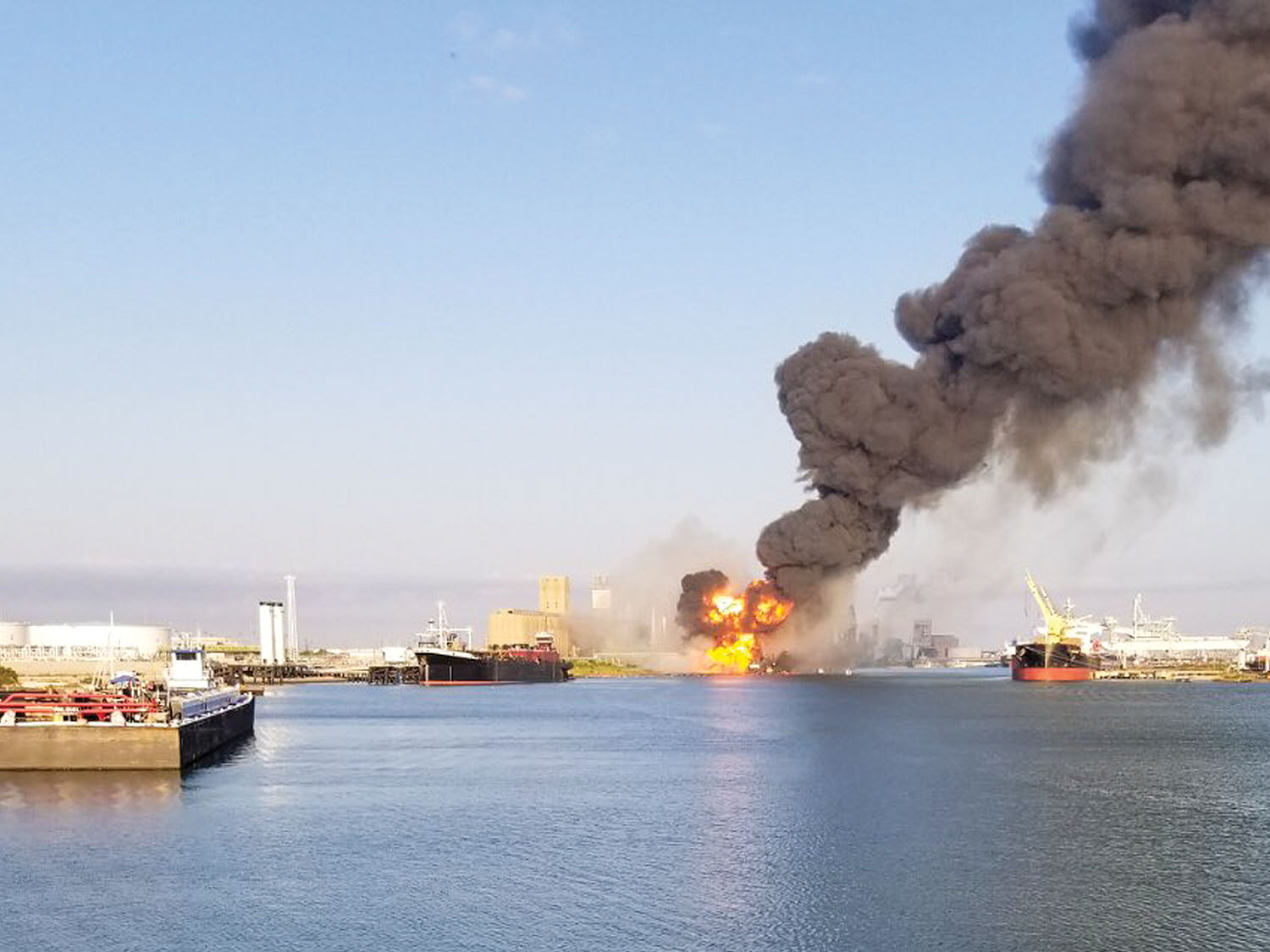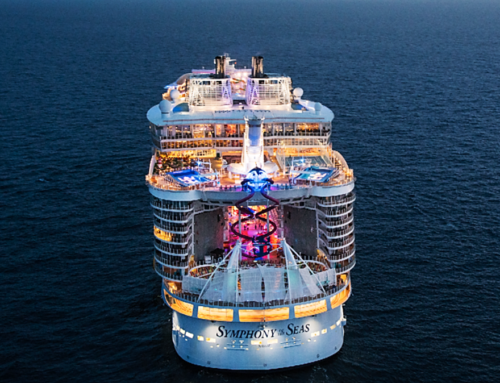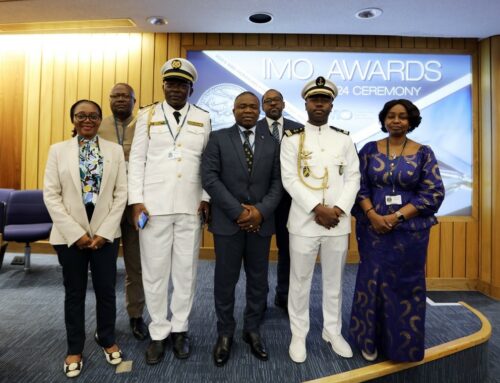NTSB Report: Numerous Errors Led to Fatal Pipeline Explosion, Dredge Fire

(US Coast Guard photo)
The National Transportation Safety Board has concluded that there were numerous serious shortcomings and deficiencies in safety planning and risk assessment, each of which contributed to the “totally preventable” rupturing of a pipeline in the Corpus Christi Ship Channel by a cutterhead dredge, the WAYMOND L. BOYD, on August 21, 2020. The NTSB held a virtual public board meeting a week ago, on December 7, during which final recommendations from its teams’ examination of the incident were accepted into its comprehensive report. The December 7 meeting was the first time the full NTSB met to consider the various reports of the numerous investigative teams, each of which focused on different aspects of the incident.
Following its investigation, the NTSB issued a total of 10 recommendations: 1) three to the Pipeline and Hazardous Materials Safety Administration 2) one to Coastal and Marine Operators; 3) two to Coastal and Marine Operators and the Council for Dredging and Marine Construction Safety: 4) three to Orion Group Holdings, owner/operator of the dredge; and 5) one to Enterprise Products, owner/operator of the pipeline.
NTSB Chair Jennifer Homendy commented: “We have seen time and time again that tragedies happen when parties fail to have the appropriate policies and procedures in place for safety….Orion Marine Group’s inadequate planning led to this tragic event and cost lives. It is absolutely critical, when excavators conduct any dredging operations near underwater pipelines, that proper precautions are in place to ensure safety.”
The pipeline rupture caused a huge fireball that enveloped and destroyed the dredge. Four crewmembers died immediately, another died later of injuries, and six more were seriously injured. The dredge WAYMOND L. BOYD, valued at nearly $9.5 million, was a total loss. Damage to the pipeline was over $2 million, and damage to the Epic oil terminal was estimated at $120,000.
The explosion occurred around 8 a.m. in the upper reaches of the Corpus Christi Ship Channel. In response, the U.S. Coast Guard initially closed the port’s inner harbor, upstream from the Harbor Bridge, and launched a MH-65 Dolphin helicopter to the area. Two injured crewmembers of the WAYMOND L. BOYD were hoisted aboard the helicopter and transported to a nearby hospital. Two 45-foot response boats from Coast Guard Station Port Aransas also responded, as did crews from Coast Guard cutters Chinook, Sturgeon and Manta; the Port of Corpus Christi police and fire departments; Signet Maritime tugs; the U.S. Army Corps of Engineers; the Texas Commission on Environmental Quality; and the Texas General Land Office.
Emergency responders battled the blaze aboard the dredge for 14 hours on August 21, finally extinguishing the fire at 10 p.m., when the vessel broke in two and sank. Search and rescue efforts continued throughout the fire-fighting effort, Early the next morning, the body of one of the missing crew members was recovered; the body of a second missing crew member was located about 10:45 a.m. that day.
The Texas General Land Office, which led the oil spill response, reported about 1,600 gallons of diesel fuel had been removed from the water, along with 680 gallons of a diesel fuel/water mix.
Among the teams’ findings:
- Orion Group Holdings had no written procedures or policies for planning operations near pipelines. Its safety meeting included general information about weather, personal protective equipment and other matters not specific to the site itself. It had no evacuation procedures in case of a pipeline emergency, which could have resulted in quicker reactions.
- The engineering plans that the terminal operator, Epic, submitted did not accurately show the proximity of the pipeline to the dredging area. These inaccurate plans were uploaded into dredging software that the operator who guided the cutterhead, called a leverman, relied on.
- Orion did not have written procedures or policies for uploading information into its dredging “Dredgepack” software. The NTSB concluded specifically that Orion had no written procedures for entering information about pipelines into Dredgepack. NTSB investigators, while working later with the software’s developer, Hypack, determined that the correct information could have been uploaded easily into the system in about four minutes.
- Correct information about the slope from the bank to the dredged area, which included the pipelines, was not shaded or marked on the charts given to the Orion teams. Instead, the Dredgepack software calculated and generated its own slope, using an algorithm, rather than the actual slope.
- Once the information had been uploaded into Orion’s software Dredgepack, Orion assumed the information was correct. Orion’s leverman, who operated the cutterhead but was not able to directly see it, testified that he believed the cutterhead was “not outside the template.” However, the cutterhead actually was operating within 1 foot of the pipeline, well below the established margin of error of 3.3 feet. The leverman guided the cutterhead according to a screen display, which simply showed its location as a large “X,” and feet were reduced to pixels.
- The pipeline’s operator, Enterprise Products performed a pipeline survey in 2018 which accurately identified the pipeline location. However, the 2018 survey that was provided to Orion did not include or reflect the location of tolerance zones or “no-go” areas.
- Orion included Epic representatives in its planning meetings, but it did not include anyone from Enterprise in those meetings.
- Orion’s safety planning did not address immediate responses in case of a pipeline rupture, which include securing or shutting off all ignition sources. Consequently, after the initial pipeline rupture, an aerosol of mixed propane gas and water engulfed the dredge, and then was drawn via vents into the dredge’s engine-room, where it encountered an ignition source and caught fire inside the dredge.
- Texas regulations governing distances and tolerance zones to pipelines were drawn up with land-based pipelines in mind, so may not be fit for purpose in marine construction projects.
- Since the pipelines were deemed to be outside the dredging area, they were not marked with required markings, which would have included buoys, to be been placed every 20 feet. Instead, an Orion team member informally requested “courtesy markings”, as he was concerned about the dredge’s anchor placement, not dredging. The courtesy markings, which were not required, consisted of cane poles and were placed every 200 feet, rather than every 20 feet. Those cane poles eere less visible and were not designed to guide dredge operators in avoiding pipelines.
In its report, the NTSB concluded that marine dredging projects require a greater level of collaboration and review between pipeline operators and dredging companies than the one-call process provides because of the challenges associated with marking marine pipelines and the lack of precision associated with dredging operations. In addition, third-party damage prevention efforts would be improved if dredging companies obtained accurate location data from pipeline operators for pipelines within and near dredging project boundaries, so they could incorporate correct data into dredge control software files.
The NTSB report’s executive summary, probable cause determinations, findings and safety recommendations are in the abstract, on the investigation web page. The full NTSB report should be available on the NTSB website in several weeks. The public docket for the investigation contains nearly 2,800 pages of factual information, including interview transcripts, photographs and other investigative materials.
We at the Herd Law Firm call upon dredging companies, pipeline operators, and dock owners to be sure their information is correct and shared with necessary partners. We are proud to represent mariners who work on dredges and other maritime equipment, ships and vessels. These brave men and women walk into harm’s way every day they go to work, and surely are due safe working environments in which to perform their critical jobs.







